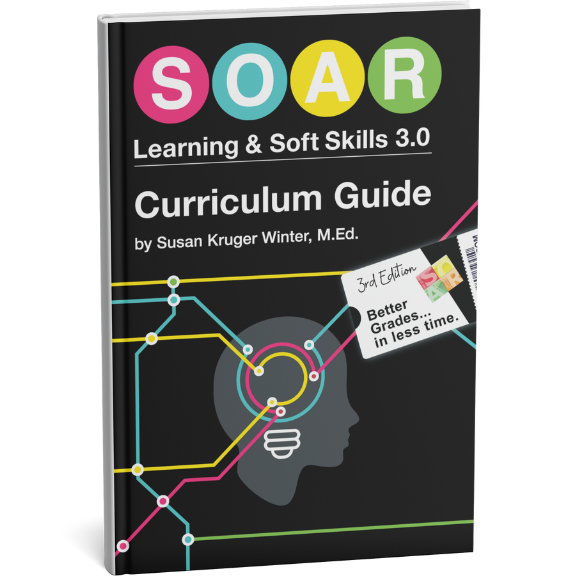Why Is Simplicity So Complicated?
“Simplicity is the ultimate sophistication.” – Leonardo da Vinci
We are naturally programmed to over-complicate matters. It actually takes effort to recognize simple solutions.
In fact, most of the time I spend with clients is on the importance of keeping study and organizational strategies simple. I could tell you hundreds of stories, but one stands out, in particular.

A few years ago, a school on the west coast flew me out to facilitate a workshop with their teachers. They were going to set their students up with the SOAR Binder System at the beginning of the year. Then I would come in three weeks later to work with teachers, answer questions, and iron out a study skills plan for the remainder of the school year.
The administration sent me an email asking what supplies I recommended for the students. I replied with very specific descriptions, including size and style specifications.
When I arrived at the school early one September morning, the teachers were a bit reserved. They weren’t rude by any means, but I usually find teachers to be very warm and welcoming. That morning, they were lukewarm, at best.
I didn’t think much of it until a hand shot up from the back of the room. I always welcome questions, but it’s rare to get such an eager question so early in the morning.
The teacher asked about the binders her kids were using. I don’t remember her exact question, but I remember being puzzled by it. Almost immediately, another teacher shot up her hand from the front of the room and asked another equally perplexing question about the binder.
Suddenly something clicked in my head, as I sensed the frustration seeping out of these poor teachers. Before I answered the second question, I cautiously asked, “What size binders do your students have?”
A third teacher sitting way on the other side of the room stood up and slammed a 3-inch binder on her table. “This is what we have for our students!” she said in a huff. As I suspected, their binders were way too large.
Have you ever seen a 3-inch binder? They are so big, you can’t even buy them at retail office supply stores. The only people who use them are insurance companies who need a place to hold the thousands of pages outlining all of the reasons why they won’t pay you for your claims.
My point is, 3-inch binders are huge! They are absolutely not appropriate for a student to cart around high school and back and forth from school to home. They don’t fit in a book bag, are too big for a student to carry in one arm, and have so many moving parts that holding one is like trying to hold a marionette puppet upright… without the strings.
Of course, everyone in that room had seen that issuing 3-inch binders to students had been an EPIC FAIL! And, the teachers all thought this was my brilliant idea.
Whoa! I calmly explained that I never recommend a binder any larger than 1.5 inches wide. I even walked over to a copy of my book and flipped to the page where I specify that point VERY clearly. After probing a bit, I figured out what happened…
When I sent my supply recommendations back to the administrative team, a couple of people on the team did not believe that all a student’s papers and notebooks could actually fit in a 1.5-inch binder. They made the executive decision to make the system “better” and purchased the larger binders.
But bigger is rarely better!
I have tested this system throughout my own schooling career and with thousands of other schools and students, and everything fits just fine! (Goes to show you how much junk we carry around every day that we don’t even realize!) Of course, there is a simple system that goes along with this 1.5-inch binder, but my point is this…
The more we try to “improve” things, the more likely they are to fall apart.
This school spent three times as much money (thousands of dollars!) on “bigger and better” binders for every kid in the school. Instead, the huge binders were a total flop.
Not Everything Is Created Equal… This Includes Binder Systems
When I mention the SOAR Binder System, a parent or teacher will often say something like, “We’ve tried using a binder, but it didn’t work. My son won’t use it.” I instantly know why it didn’t work (too many connections on the brain circuit), but I will ask for details to clarify.
Sure enough, they will describe a system involving lots of tabs, hole-punching papers, extra folders that don’t fit, and spiral notebooks jammed inside… say it with me: COMP-LI-CATED!
No wonder the “binder system” didn’t work for their child! It wasn’t a paper-organization system; it was a manufacturing-of-useless-work system.
I’m not criticizing anyone in particular. I know I over-complicate many other things in my life. It’s just that it can be so darn difficult to make this point clear. Whatever I do or say about simplicity, people will still add “enhancements” to these systems.
Since these strategies are closely aligned to brain circuitry, they are fairly universal. I do support modifications to meet personal preferences, but when we add an “enhancement,” we need to be aware of how many steps on the brain circuit we are actually adding to the process. This is why the brain circuit model is so important for us to understand. We need to be willing to weigh out whether the additional steps are really worthwhile.
So, what’s my point?
- Over-complication is easy at the beginning. Simplification is challenging at the beginning.
- Over-complication makes steps two through infinity very painful. Simplification makes steps two through infinity infinitely easier!
- If “binder systems” have failed in the past, chances are that they were seriously overloading the circuits.
See It For Yourself…
Within 10 minutes, you can see for yourself how we “magically” transform paper management from 22 demands on the brain circuitry to 5 simple steps. You can get your child on the road to successful paper management as you watch our SOS (Simple Organization System) Binder videos. The SOS Binder videos are part of the SOAR Learning & Soft Skills App. Get it now here.
Sincerely,
Susan Kruger Winter, M.Ed.
Former Struggling Student
Creator of SOAR
Six Steps
Conquer the Chaos
Get Our Free Guide & Information on...

"*" indicates required fields
Get Our FREE Curriculum Guide!
The SOAR® Curriculum
The most critical learning, organizing, and communication skills needed for school. Learn more here.
Who’s Using SOAR®?
SOAR® Guarantee
Click here to learn more.




